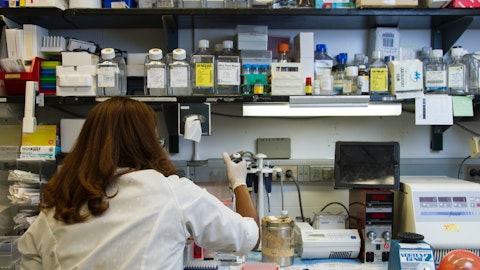Yvonne Greenstreet: Great. Okay. Next question.
Operator: Thank you. [Operator Instructions] Our next question comes from the line of Maury Raycroft from Jefferies.
Maury Raycroft: Hi. Thanks for taking my question. With the new stats plan and the latest conversations with regulators, can you talk more at this point on what the minimum delta and the composite endpoint is that you need to achieve to be stat sig [ph] for monotherapy and combo therapy? And in the top line update, can you commit to reporting when you first hit stat sig on the separation of the curve, so we get a sense of kinetics versus competitor drugs?
Pushkal Garg: Yes. Maury, I think what I would say is a couple of things. First of all, I think it’s widely accepted that death and hospitalization are incredibly clinically relevant endpoints, and so there is no sort of minimum threshold there. Obviously, there is always benefit risk. But in general, any benefit in terms of death and hospitalization is considered clinically significant, is very different than scenarios of looking at NT-proBNP or six-minute walk test or things like that. And as we have said, what we are committing to in the primary – in the top line results is we will provide p-values on the primary and secondary endpoints, we will provide a statement on safety, and we will make – we will provide information on relevant subgroups, including the TAP subgroup. And of course, we will be providing a lot more data as is our custom, we tend to be quite transparent with our data at scientific and congresses, etcetera, thereafter.
Akshay Vaishnaw: And as to the kinetics of the effects of either patisiran or vutrisiran for that matter, it’s quite clear that the onset is – appears to be much more rapid than has been seen in other trials with other drugs. So, for example, in the original APOLLO with patisiran, by six months, you are seeing the separation post of analysis, but you are seeing a separation in mortality and hospitalization. The same was true in APOLLO-B emerging at nine months. When you look at recent studies in the ATTR-CM space, it’s nothing like that. And my point is that more timely are further attested to by the time separation of six-minute walk distance or KCCQ, which also promptly occurred within the first few months of the study.
So, I think not just the magnitude of effect that the kinetics of how our drugs work by depleting the pathogenic protein, which certainly in the [indiscernible] seems to be very potent way to treat the disease, will undoubtedly show the impact, I think ultimately and towards…
Yvonne Greenstreet: Great. Thank you.
Operator: Thank you. [Operator Instructions] Our next question comes from the line of Mike Ulz from Morgan Stanley.
Mike Ulz: Good morning. Thanks for taking the question. Maybe just one on APOLLO-B. You highlighted the AMVUTTRA monotherapy arm did better than the combination of arm of AMVUTTRA and tafamidis. And I think you highlighted that back at the R&D Day. But just curious, what’s the rationale or the mechanism or reason why the combo performs worse than the monotherapy arm? Thanks.
Pushkal Garg: Yes. Mike, maybe just to clarify a couple of points, right. I think first of all, what we are saying is that we – when we look at the monotherapy data, it’s – you are looking at the effects of – effect of one drug and certainly comparing that to placebo. And so those placebo patients tend to decline, and it gives the cleanest perspective on the impact that your drug is having, right. And what we have seen out of APOLLO-B, like, was really quite potent substantial effects on the four key powered endpoints that we looked at in that study, six-minute walk test, KCCQ, NT-proBNP and troponin that were sizable and durable. We also saw benefits on mortality as we have been talking about. Some people have brought up some of the data around time to event or – and the recurrent CV events.
And I would just point out that, one, it’s one endpoint out of all. So, I think you would have to kind of question why that would be the case, and if that makes any clinical or biologic sense. Moreover, when we look at those data, actually, the lack of apparent separation was due to a few early events that happened in the patisiran arm in the first three months. And if you look beyond three months, in the first three months, the drug is just starting to take effect. Beyond three months, we actually see good separation even in the monotherapy group even on outcomes and recurrent CV events specifically. So, I think all of that bodes very well. And as it relates to combination, as we have said along, we are very encouraged. But certainly, just like you see in blood pressure medicines or other things when you start to combine effective therapeutics together with different mechanisms of action, it can change the magnitude of effect that you might detect.
But everything that we are seeing coming out of APOLLO-B suggest that there will be an effect there, and it’s most visibly seen by the outcomes data that we talked about in that study.
Akshay Vaishnaw: Yes. We are going to have a much larger study with HELIOS-B and on the…
Yvonne Greenstreet: Large and longer study.
Akshay Vaishnaw: Absolutely.
Yvonne Greenstreet: And investments that large and long the study and that is our friend here, then for the patients and solutions ultimately showing a positive outcome. Just before this Pushkal, you and I were looking at the calmative space. And if they would look at month 18, tafamidis was faring worse than placebo for mortality. So, looking at the wrong time point in a study that’s smaller can really lead you a spread and so APOLLO-B was highly informative, but targeting that one or two of the endpoints didn’t line up where the vast majority did. And ultimately, our friend is the largest, longest study that’s ever been conducted and will shortly be completed in ATTR, and that CSB. So, I think getting too over-indexed on one endpoint that went in the wrong direction, you have to be careful about that.
Christine Lindenboom: Good. I think we have got time for one more question, one last question.
Operator: Thank you. Our last question comes from the line of William Pickering from Bernstein.
William Pickering: Hi. Thank you for taking my question. What is the powering of the study with respect to the overall population at the 0.025 significance level, like, I think a lot of the changes make sense, but you have also said in the past that the study is not powered for stat-sig in monotherapy. So, if that doesn’t hit, are you then in like a more difficult position than you were before the stats plan change? Thank you.
Pushkal Garg: Yes. Well, no, I think what I would take away from today is that the changes we make really we think we have actually enhanced the overall statistical power of the study by adding an extra follow-up for those patients. At the tail end of the study, we think we have added – we certainly have added statistical power there. And the way that we have constructed this endpoint, which again remains focused on the most critical endpoint, which is outcomes, we were allowed to – we were able to look now in the full totality of the population, 660-plus patients in the combination – in the overall as well as – the way I would think about it an enriched population of the monotherapy patients, who we expect to be – have the largest treatment effect and the purist demonstration of what vutrisiran can accomplish in this and do in this disease.
And so we really think we have – that’s really what we have done here. And so we don’t think that we have, in any way, made it harder. We think that we have actually made the study better and aligned it where, as Tolga highlighted, where we think the market is going to be for the next several years.
Yvonne Greenstreet: Yes, absolutely. That’s great. I think we need to bring the call to a close. I would like to thank everybody for joining us today. As I have said, we are really pleased with the execution. We were looking at 2023, hitting on our 2024 goals and coming [Technical Difficulty] company. So, thank you all and have a great day.
Operator: Thank you. This concludes today conference call. Thank you for participating. You may now disconnect.
Follow Alnylam Pharmaceuticals Inc. (NASDAQ:ALNY)
Follow Alnylam Pharmaceuticals Inc. (NASDAQ:ALNY)
Receive real-time insider trading and news alerts





